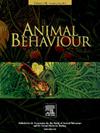Volatile odours reflect breeding status but not social group membership in captive Damaraland mole-rats
IF 2.3
2区 生物学
Q2 BEHAVIORAL SCIENCES
引用次数: 0
Abstract
In mammals, olfaction plays a key role in social behaviour, for example, in identifying mating opportunities and potential rivals. However, we still have a limited understanding of how social information is encoded in animal odours, including the social determinants of chemical similarity and diversity. Here, we used gas chromatography to analyse the chemical composition of swabs taken from the facial and anogenital regions of Damaraland mole-rats, Fukomys damarensis, a highly social subterranean mammal that relies almost exclusively on olfactory and tactile social cues. We found no sign of individual identity across the two body areas sampled; samples from the facial region and samples of the anogenital region from the same individual were not similar to each other, suggesting that these regions carry different information. However, chemical profiles varied significantly by sex and breeding status; female breeders differed from nonbreeders in their anogenital profiles and had higher chemical diversity in their facial profiles compared with both males and nonbreeders. Interestingly, we found no signals of social group identity. Instead, individual identity may be conveyed through signature mixes that are learned through frequent contact, rather than through specific odours associated with genetic kinship or social group membership. Our results highlight the complexity of chemical communication systems in social species and suggest that signals of group level identity are not necessary for behavioural responses based on group membership.
挥发性气味反映了圈养达马拉兰鼹鼠的繁殖地位,而不是社会群体成员
在哺乳动物中,嗅觉在社会行为中起着关键作用,例如,识别交配机会和潜在对手。然而,我们对动物气味中社会信息的编码方式,包括化学相似性和多样性的社会决定因素的理解仍然有限。在这里,我们使用气相色谱法分析了从达马拉兰鼹鼠(Fukomys damarensis)面部和肛门生殖器区域提取的拭子的化学成分。达马拉兰鼹鼠是一种高度社会性的地下哺乳动物,几乎完全依赖嗅觉和触觉的社交线索。我们在两个取样的身体区域中没有发现个体身份的迹象;来自同一个体的面部区域样本和肛门生殖器区域样本彼此不相似,表明这些区域携带不同的信息。然而,化学特征因性别和繁殖状况而有显著差异;雌性繁殖者与非繁殖者在性器官特征上存在差异,面部特征的化学物质多样性高于雄性和非繁殖者。有趣的是,我们没有发现社会群体认同的信号。相反,个体身份可能是通过频繁接触而习得的特征混合来传达的,而不是通过与遗传亲缘关系或社会群体成员关系相关的特定气味。我们的研究结果强调了社会性物种中化学通讯系统的复杂性,并表明群体水平的身份信号对于基于群体成员的行为反应不是必需的。
本文章由计算机程序翻译,如有差异,请以英文原文为准。
求助全文
约1分钟内获得全文
求助全文
来源期刊

Animal Behaviour
生物-动物学
CiteScore
4.60
自引率
8.00%
发文量
236
审稿时长
10.2 weeks
期刊介绍:
Growing interest in behavioural biology and the international reputation of Animal Behaviour prompted an expansion to monthly publication in 1989. Animal Behaviour continues to be the journal of choice for biologists, ethologists, psychologists, physiologists, and veterinarians with an interest in the subject.
 求助内容:
求助内容: 应助结果提醒方式:
应助结果提醒方式:


